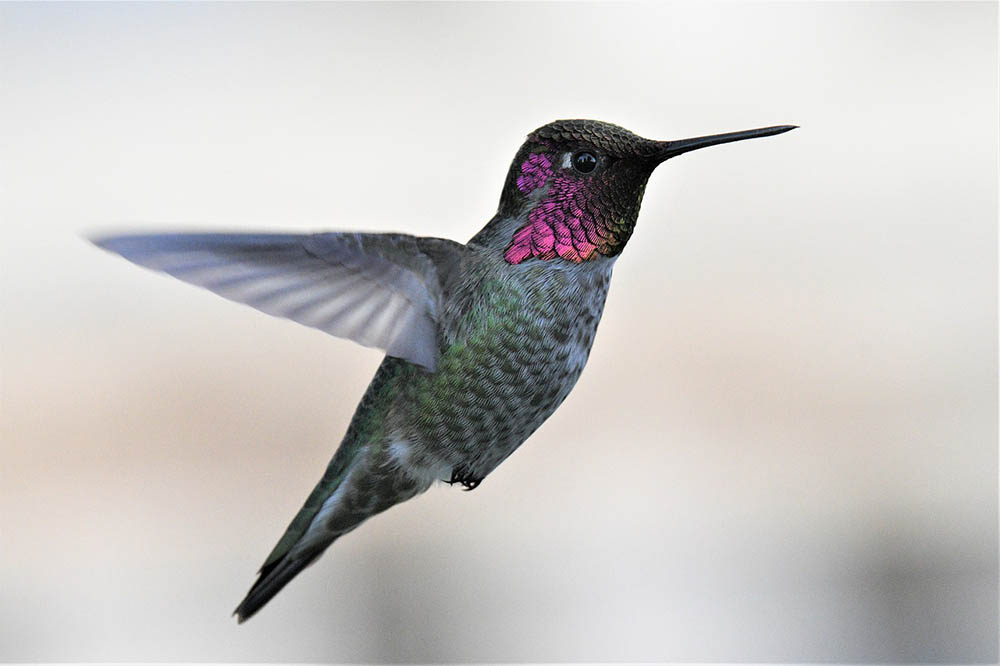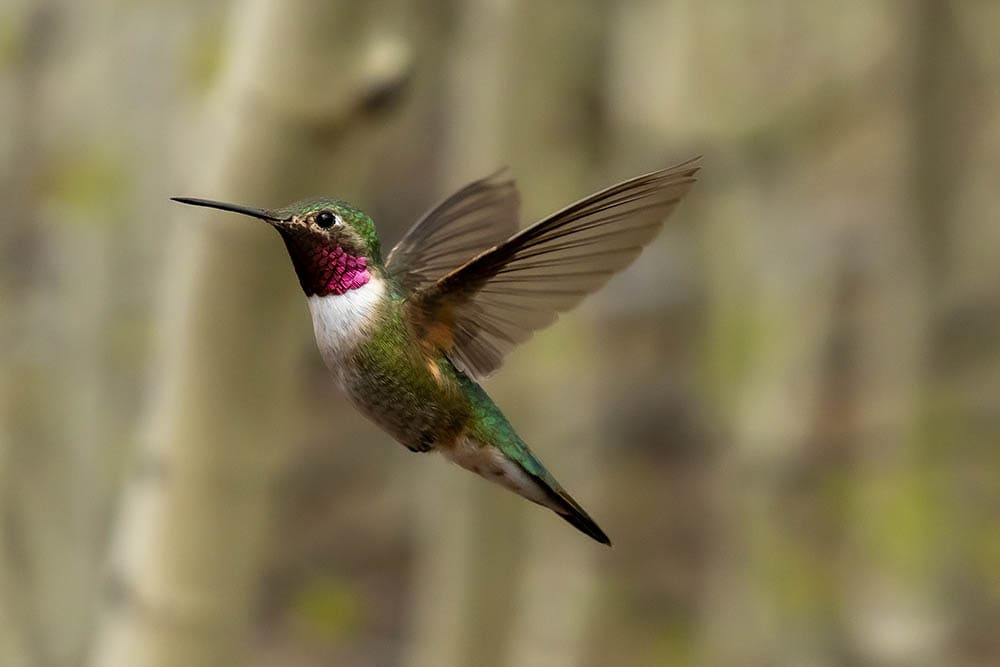11 Types of Hummingbirds in Florida (With Pictures)
Last Updated on

Hummingbirds are unique from other birds in the animal kingdom, with their jittery wings, distinctly long bills, and magnificent colors. Across the country, you can find a myriad of members in the Trochilidae family, but today we will be discussing their domain in Florida.
These are 11 types of hummingbirds in the Sunshine State, with information on their location, feeding, nesting, and other behaviors!

The 11 Types of Hummingbirds in Florida
1. Ruby-throated Hummingbird

| Scientific name: | Archilochus colubris |
| Family: | Trochilidae |
| Endangerment: | Stable |
The most well-known and abundant hummingbird in the United States is the ruby-throated hummingbird. This species gets its name from the shining red accent along its neck, which is complemented by an emerald and turquoise body. Ruby-throated hummingbirds are a common sight in backyards, as they are always up for a swig of sugar water. They nest in woodland biomes across Florida, but you’ll have better luck seeing them in the south during winter.
2. Buff-bellied Hummingbird

| Scientific name: | Amazilia yucatanensis |
| Family: | Trochilidae |
| Endangerment: | Stable |
Found exclusively in the Florida Panhandle, the buff-bellied hummingbird is strewn with colors; green, gray, purple, cream, and orange. It hovers over flowers and draws out the nectar from inside, returning to its tree nest in the open woodland biome. However, they are keen on nectar feeders as well, especially when paired with a well-kept garden. The best time to see this bird is during the winter months, as it only lives in Texas year-round.
3. Bahama Woodstar
https://www.instagram.com/p/CiGb4_HgOvi/
| Scientific name: | Nesophlox evelynae |
| Family: | Trochilidae |
| Endangerment: | Stable |
Coming from The Bahamas, this little hummingbird has a flurry of colors; a greenish-blue coat, orange underbelly, black wings, white under the throat, and a black (female) or purple (male) throat. Bahama woodstars live quite close to their native island nation, with populations concentrated in the east-central coastline, as well as the Everglades National Park. You can find this bird in gardens, shrublands, and wooded areas. They love to feed on nectar; don’t be afraid to put out a feeder!
4. Calliope Hummingbird
https://www.instagram.com/p/ChQ6KDBraEy/
| Scientific name: | Selasphorus calliope |
| Family: | Trochilidae |
| Endangerment: | Stable |
Calliope hummingbirds are scattered across Florida’s western and northern domains, as they’re found in Tampa, Jacksonville, and The Florida Panhandle. Here, you can find these hummingbirds grazing flowers and sugar-water feeders in both residential and rural areas. To identify one, look for short tail feathers and an emerald green back coating. Male calliopes have a vibrant purple throat, whereas females are fully white. Look for meadows or areas with little to no trees for the best chance of finding them in the wild.
5. Allen’s Hummingbird

| Scientific name: | Selasphorus sasin |
| Family: | Trochilidae |
| Endangerment: | Stable |
Allen’s hummingbird consists of a unique orange color glazed on its throat, tail, eyes, and undercoat. A male has a faint jade back that extends to its head, doused in white near the belly. However, they look strikingly similar to Rufous hummingbirds. Their tail feathers are the only way to separate them consistently, but it’s not easy because of their quick movements and small size. Allen’s hummingbirds’ range in Florida spans from Tampa to Tallahassee, along with a few other communes in the central and northeastern sides of the state.
6. Rufous Hummingbird

| Scientific name: | Selasphorus rufus |
| Family: | Trochilidae |
| Endangerment: | Unstable |
Similar to Allen’s hummingbird, a male Rufous hummingbird has a bright orange coating with a green back, in addition to a white belly underneath. However, females do have an orange back and sides. Finding a Rufous hummingbird is much easier than Allen’s hummingbird because their populations are spread throughout every corner of the state. They live in wooded areas and feed mostly on insects and flower nectar.
7. Broad-tailed Hummingbird

| Scientific name: | Selasphorus platycercus |
| Family: | Trochilidae |
| Endangerment: | Stable |
Broad-tailed hummingbirds and ruby-throated hummingbirds look alike, but you can tell the difference by looking for the pinkish throat rather than the red of the ruby-throated hummingbird. Also, the face of a broad-tailed hummingbird is lightly colored. This species is common, but its range is limited to the Florida Panhandle, in cities such as Tallahassee and Mobile. It wouldn’t be a bad idea to set out a nectar feeder, as its only other food is insects.
8. Broad-billed Hummingbird

| Scientific name: | Cynanthus latirostris |
| Family: | Trochilidae |
| Endangerment: | Unknown |
The colors of a male broad-billed hummingbird are eye-catching, to say the least; its body is covered in glimmering blue and green, as well as a flamingo-colored bill. Females have a grayish belly, with a blackish bill and dark-spotted cheeks. Broad-billed hummingbirds are found in many places in Florida, but they primarily inhabit the northern region of the state. Look in forested areas with flower patches or in suburban gardens. They are frequent at water feeders as well!
9. Costa’s Hummingbird

| Scientific name: | Calypte costae |
| Family: | Trochilidae |
| Endangerment: | Stable |
Found exclusively in the greater Tallahassee area, male Costa’s hummingbirds boast a magnificent mask of purple that extends to their throat, with the rest of their body covered in white and faint green. Females look pretty much the same, but without the purple mask. They have a high-pitched call that can be heard from gardens, fields, and meadows. Costa’s hummingbirds are fond of sugar feeders, so don’t forget to set one out if you live in this city.
10. Black-chinned Hummingbird

| Scientific name: | Archilochus alexandri |
| Family: | Trochilidae |
| Endangerment: | Stable |
The black-chinned hummingbird was named for its coal-colored head and chin, but the males of this species also have a streak of purple that shines just below the chin. Layered with a white belly and faint blackish-green back, this hummingbird is abundant in the winter. It’s found in woodland forests that are plentiful in flowers, which can be located throughout the entire state. They’re also populated in all of Florida’s major cities.
11. Anna’s Hummingbird

| Scientific name: | Calypte anna |
| Family: | Trochilidae |
| Endangerment: | Stable |
Anna’s hummingbird is another Trochilidae that displays green, blue, and pink hues across its body. Males may have a fully pink head, which is an easy way to identify this species in broad daylight. Females do not show any pink, nor do immature males. During non-breeding periods, Anna’s hummingbirds inhabit the Florida Panhandle, in cities such as Pensacola and Tallahassee. They often sip on water feeders, as they live close to gardens and vegetated suburban areas.

Final Thoughts
Hummingbirds almost always exhibit vibrant, flashy colors that make them a specialty in the birding community. Their aerial adaptations allow them to fly in any direction—even backward. Florida is a great state for them to thrive due to the wet, tropical climate that allows for flowers to bloom steadily. Next time you’re in the Sunshine State, look for the green, purple, and red colors that make the hummingbird an incredible sight to behold!
See also: 6 Types of Hummingbirds in Michigan (With Pictures)
Featured Image Credit: Veronika_Andrews, Pixabay
Table of Contents
About the Author Robert Sparks
Robert’s obsession with all things optical started early in life, when his optician father would bring home prototypes for Robert to play with. Nowadays, Robert is dedicated to helping others find the right optics for their needs. His hobbies include astronomy, astrophysics, and model building. Originally from Newark, NJ, he resides in Santa Fe, New Mexico, where the nighttime skies are filled with glittering stars.
Related Articles:
Monocular vs Telescope: Differences Explained (With Pictures)
10 Types of Hummingbirds in Arkansas (With Pictures)
8 Types of Hummingbirds in Nebraska (With Pictures)
5 Types of Hummingbirds in Idaho (With Pictures)
3 Types of Hummingbirds in Mississippi (With Pictures)
8 Types of Hummingbirds in Kansas (With Pictures)
5 Types of Hummingbirds in West Virginia (With Pictures)
5 Types of Hummingbirds in Ohio (With Pictures)
